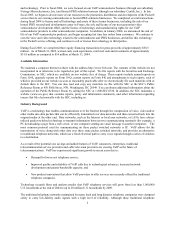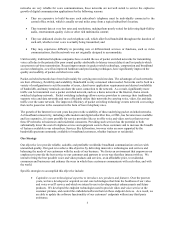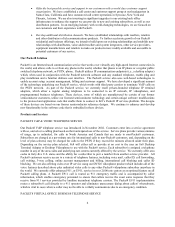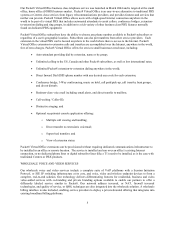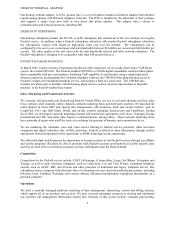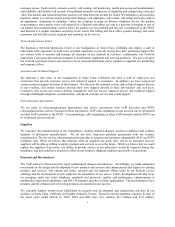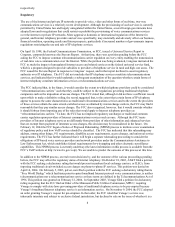8x8 2005 Annual Report Download - page 15
Download and view the complete annual report
Please find page 15 of the 2005 8x8 annual report below. You can navigate through the pages in the report by either clicking on the pages listed below, or by using the keyword search tool below to find specific information within the annual report.12
technology in the United States and internationally. We currently rely primarily on a combination of trade secrets,
patents, copyrights, trademarks and licenses to protect our intellectually property. As of March 31, 2005, we had
fifty-eight United States patents that have issued and a number of United States and foreign patent applications
pending, none of which we consider critical to our business. Our patents expire on dates ranging from 2009 to 2018.
We cannot predict whether our pending patent applications will result in issued patents.
To protect our trade secrets and other proprietary information, we require our employees to sign agreements
providing for the maintenance of confidentiality and also the assignment of rights to inventions made by them while
in our employ. There can be no assurance that our means of protecting our proprietary rights in the United States or
abroad will be adequate or that competition will not independently develop technologies that are similar or superior
to our technology, duplicate our technology or design around any of our patents. We are also subject to the risks of
adverse claims and litigation alleging infringement of the intellectual property rights of others. The communications
and software industries are subject to frequent litigation regarding patent and other intellectual property rights. In
addition, the laws of foreign countries in which our products are or may be sold do not protect our intellectual
property rights to the same extent as do the laws of the United States. Our failure to protect our proprietary
information could cause our business and operating results to suffer.
We rely upon certain technology, including hardware and software, licensed from third parties. There can be no
assurance that the technology licensed by us will continue to provide competitive features and functionality or that
licenses for technology currently utilized by us or other technology which we may seek to license in the future will
be available to us on commercially reasonable terms or at all. The loss of, or inability to maintain existing licenses
could result in shipment delays or reductions until equivalent technology or suitable alternative products could be
developed, identified, licensed and integrated, and could harm our business. These licenses are on standard
commercial terms made generally available by the companies providing the licenses. The cost and terms of these
licenses individually are not material to our business.
Licensing and Development Arrangements
Historically, we entered into licensing and development arrangements with our semiconductor and IP PBX
customers to promote the design, development, manufacture and sale of our products. We have licensed portions of
our systems technology and software object code for our semiconductors to virtually all of our semiconductor
customers. Such arrangements may enable these companies to use our technology to produce products that compete
with our Packet8 telephony and video products. We have also licensed the right to manufacture certain of our video
and VoIP telephony semiconductor products to several original equipment manufacturers, or OEMs. These licenses
generally provide for the payment of royalties. Only certain of these OEM licensees may sell semiconductors based
on the licensed technology to third parties, while other licensees are limited to sales of such semiconductors as part
of multimedia communication systems or sub-systems. We expect to continue licensing our technology to others,
many of whom may be located outside of the United States. In addition to licensing our technology to others, we,
from time to time, may take a license to technology owned by third parties and currently rely upon certain
technology, including hardware and software, licensed from third parties.
Information about Segments and Geographic Areas
We have only one reportable segment. Financial information relating to our product lines and information on
revenues generated in different geographic areas are set forth in Note 12 to our consolidated financial statements
contained in Part II, Item 8 of this Report.
Employees
As of March 31, 2005, our workforce consisted of ninety-three employees and sixty-five contractors. These
employees and contractors include ninety-six in operations, thirty-four in research and development, seventeen in
sales and marketing and eleven in general and administrative capacities. None of our employees are represented by a
labor union or are subject to a collective bargaining arrangement.
ITEM 2. PROPERTIES
Our principal operations are located in an approximately 47,000 square foot facility in Santa Clara, California that is
leased through August 2009. Design, testing, research and development, sales and marketing, shipping, customer


